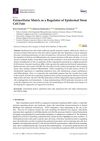TLDR Newborn skin is uniquely prepared to adapt to new environments compared to adult skin.
The study compared gene expression in full-thickness skin samples from 27 newborns and 43 adults, revealing significant differences. Over 25,000 differentially regulated probe sets, representing 10,647 genes, were identified. Infant skin showed increased activity in 143 biological processes, such as ECM organization and cell adhesion, while adult skin had 101 enriched processes related to epidermal development, immune function, and hair cycle. These findings highlighted the unique readiness of infant skin to adapt to new environmental challenges and suggested potential strategies for maintaining healthy skin development.
97 citations
,
May 2019 in “Frontiers in Cell and Developmental Biology” Abnormal ECM and immune cell interactions can cause skin diseases.
65 citations
,
September 2014 in “BMC genomics” Different hair types in mammals are linked to variations in specific protein genes, with changes influenced by their living environments.
 87 citations
,
September 2019 in “Nature Communications”
87 citations
,
September 2019 in “Nature Communications” SOX11 and SOX4 help skin cells act like embryonic cells to heal wounds in mice.
110 citations
,
April 2020 in “Advances in Wound Care” Nanotechnology shows promise for better chronic wound healing but needs more research.
 57 citations
,
March 2018 in “International Journal of Molecular Sciences”
57 citations
,
March 2018 in “International Journal of Molecular Sciences” The extracellular matrix is crucial for controlling skin stem cell behavior and health.
 June 2023 in “Frontiers in Bioengineering and Biotechnology”
June 2023 in “Frontiers in Bioengineering and Biotechnology” The conclusion is that accurately replicating the complexity of the extracellular matrix in the lab is crucial for creating realistic human tissue models.
16 citations
,
March 2024 in “International Journal of Molecular Sciences” Natural compounds and biomimetic engineering can improve wound healing by enhancing fibroblast activity.




